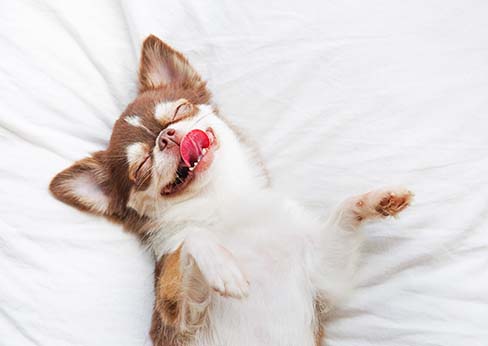Sleeping is an important part of a dog’s life, and you have to admit, they look pretty cute when they’re curled up and snoring away. But dogs don’t just sleep because it’s adorable. Just like in people, sleep for dogs is a critical aspect of their health.
To give you an idea of what goes on inside your pup’s head while they’re napping, we’ve outlined four fun facts about dog’s sleeping habits below!
Their Sleep Patterns Are Similar to Humans
Research conducted by Matthew Wilson and Kenway Louie of MIT proved that during sleep, dog’s brains go through similar brain wave patterns as humans. Like humans, dogs go through all the cycles of sleep; they go through three phases during non-rapid eye movement (NREM) and also go through the REM stage – the dreaming phase. However, a dog’s sleep cycle is a lot shorter than humans; where a human goes through an average of 5 cycles a night, a dog can go through 15-20 cycles!
During the first phase of NREM sleep, your dog’s muscles start to relax. This is why you may sometimes see them twitch or jerk slightly. This stage is classed as a light sleep as your dog can be woken up easily while in this stage.
Your dog will spend most of their sleeping time in the second NREM stage. In fact, it was take up to almost half of their total sleep period! While their brains may still be working, at this stage, your dog is very relaxed and calm.
The third phase of NREM is also known as “slow-wave” sleep (SWS). This phase usually lasts between 10 and 15 minutes per cycle. While they’re in the third phase, your dog’s heart rate, blood pressure, and body temperature all decrease. Their breathing slows down, and you may notice that your dog does not react to noises or activity around them.
REM sleep is when most dreams and more random movements occur because the brain is highly active, processing memories and new information. A dog only spends between 10-15% of their sleep cycle in this phase, although a puppy will spend much longer as they are still going through the developmental stages.
Yes, Dogs Dream
It won’t surprise you that dogs dream about dog things. Since dogs’ brains are more complex and show the same signs of electrical sequences, Stanley Coren a well-respected scientist and Professor of Psychology at the University of British Columbia concludes that it is reasonable to assume that dogs also dream.
While it’s unlikely that they’re dreams are as complicated or intense as ours, the best guess is that they are also dreaming about things that are “front of mind” — protecting you from dangers, chasing birds or squirrels, or romping around with other pups at the dog park. When you see your dog’s legs churning during deep sleep, it is certainly possible that they are dreaming about the type of daily activities that they are used to!
This is due to a part of the brain stem called the “pons”, which stop our large muscles from moving in our sleep and physically acting out our dreams. In young puppies, those pons are not fully developed, so they twitch and move a lot more than older dogs. In studies where pons were deactivated, researchers found that dogs will act out their dreams. This means without these pons, a dreaming pointer may immediately start searching for a game, and a dreaming Doberman pincher may pick a fight with a dream burglar.
An interesting fact about dogs’ dreams, smaller dogs dream more, while larger dogs dream less. However, a larger dog’s dreams last longer.
Why does my dog circle around in his bed?
Before lying down, you may see your dog circle their beds or wherever they’ve chosen to settle in for a nap. While this may look silly to you, this behavior dates back to prehistoric times, when dogs literally had to make their beds.
In the wild, dogs had to make a comfy bed by patting down tall grass. This behavior would also drive out snakes and insects and thus make the sleeping spot safer. You may also notice that your dog paws at his bed before lying down. This is because, in extreme heat, a wild dog could dig up cold soil to surround himself with, and when it was cold, scratching up and settling into even a shallow hole helped retain body heat. It also leaves a scent behind and a visual marker that this spot has been claimed.
How much sleep do dogs need?
Our friends at Tuck Sleep wrote a great article on the amount of sleep dogs need. Tuck Sleep is a non-commercial community devoted to improving sleep hygiene, health, and wellness through the creation and dissemination of comprehensive, unbiased, free web-based resources.
On average, dogs spend 12 to 14 hours per day sleeping. Your dog’s particular sleep needs may vary around that range, depending on his age, size, breed, activity level, and overall health:
Larger breeds tend to sleep more than smaller breeds.
Working dogs with activity-filled days sleep less, while those who lead sedentary lives will sleep more.
Puppies can spend up to 20 hours sleeping a day. Growing and learning how to be a dog takes a lot of energy!
As dogs age into their senior years, they spend more time sleeping since they tire more easily.
Wild dogs and wolves may sleep more than domesticated dogs because they have to hunt for their food, which expends more energy. When food is scarce, they need to conserve their strength, and a practical way to do that is by sleeping.
Most dog owners want to do everything that they can to help make sure that their pup is safe, happy, and healthy. Getting quality sleep every day can be a vital component of that, so be sure to develop a healthy sleeping routine for your pup!





